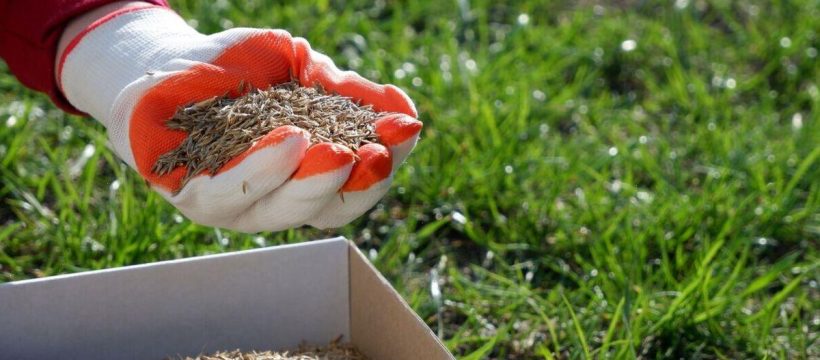
Grass seed is the go-to remedy to restore luscious green blades in your lawn but it will struggle to grow if you sow it at the wrong time of the year. While the weather is still unsteady and temperatures continue to fluctuate, it can be hard to judge the best time to make a start on those essential garden repairs ahead of the spring on March 20. To get it done quickly with no setbacks, gardening experts have shared their easy guide to get you going.
Bare patches, weeds and overgrown grass can bring down the appearance of your entire garden after winter, leaving it looking unkempt.
Though it’s tempting to mow it down and start again, lawn experts have warned against being too brash with your approach when it comes to grass seed.
Speaking exclusively to Express.co.uk, Chris McIlroy of The Grass People said: “Sowing season in the UK is generally from mid-March to September. Known as the seeding season, this is when temperatures are consistently 8-10 degrees Celsius and above, which is required for germination to occur.
“We recommend waiting until temperatures are reaching at least 8-10C, consistently for two weeks – even during the night – before you start sowing grass seed.”

For a foolproof grass-sowing plan, you should consult a two-week forecast to mitigate any risk of adverse weather or a sudden drop in temperatures.
Chris noted that this is as easy as looking at a weather app for your local area ahead of sowing. He said: “Some areas in the UK won’t reach these temperatures (8-10C) until April, while some locations in the southern part of England will experience these much sooner in the year.
“In short, grass seed takes around 10 days to grow after sowing and will be fully established and ready for use roughly six to eight weeks after initially sowing. However, this relies on several factors falling into place. Most importantly, having the right conditions at the time of sowing and just after.
“In order for grass to grow, it will need heat, air and water. A combination of all three will normally result in a quick and successful germination.”
DON’T MISS
‘Whiten’ yellow stained pillows ‘instantly’ with 4p ‘essential’ [TIPS]
Gardeners share ‘instant’ natural method to kill paving weeds [COMMENT]
‘Best solution’ to remove stubborn limescale from your shower door [EXPERT]
If you’re desperate to get ahead with growing fresh grass, you can give it a go according to Steve Williams, managing director at Mowers Online.
He told Express.co.uk that “you can successfully sow grass seeds any time of the year”, but is best done in the months between late spring when the ground is warmer.
Steve added: “With a spring sowing the grass may not root in as quickly as in the autumn because it will instead put its energy into flowering. But do look out for periods of unusually dry weather as we often have quite good springs weather-wise.”
The lawn experts agreed that watering the seeds and keeping them free from foot traffic are equally as important as choosing the right sowing conditions.

Like most planting jobs, good preparation will help to ensure you get a “top-quality lawn”, according to Steve.
He said: “For grass that is level, dense, well-rooted and weed-free, there are some vital steps to be taken so start preparing the area several weeks before sowing.”
Start by spending a generous chunk of time lifting perennial weeds, such as bindweed and couch grass by digging out the roots. The Mowers Online expert warned against using weedkillers as the residual chemicals in the soil can affect the new grass.
If the soil is hard and compacted dig or rotavate to a depth of about 20cm and add plenty of well-rotted manure or compost to help retain moisture.
According to Steve, this will also improve the quality and drainage of the soil and is better for your lawn long-term.
He added: “Leaves collected over the last few seasons can be taken from compost bins and dug well in to nourish and encourage germination. After ground preparation, leave it for a few weeks to settle but continue to weed and remove clumps of the earth to create a fine, crumb-textured seedbed.”
Once sown, the seedbed needs to be kept constantly moist until the grass is around 6cm high. If you struggle with birds pecking at the seeds, Chris recommended adopting a few natural deterrents. He suggested visual remedies like scarecrows and hanging CDs to reflect light and scare them off.
The Grass People expert added that tin cans tied to a piece of string on a tree are effective noise deterrents, along with providing alternative food sources as a distraction.
Source: Read Full Article
